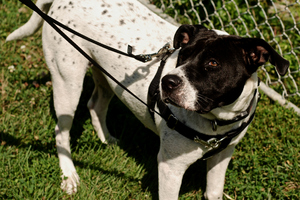Selecting the correct collar or harness for your dog

The correct gear can make walking your dog a far more pleasant experience. Photo by Jenny Murray
For your basic, flat webbing, around-the-neck collar, three things are most important:
Fit: A correctly fitted flat collar should have room for two fingers to fit between neck and collar. If it has a metal buckle (more on that below), there should be adequate length to go through the buckle and then have the end tucked under the loop. This helps secure the buckle. A good rule of thumb is to measure the dog's neck just behind the ears and add 4 inches.
Width: To prevent injury to your dog's neck and give you the most control, find the widest collar you can. 1 to 2 inches-wide is best. I see countless tiny dogs wearing fine little cat collars. Intuitively that seems right, but the reverse is true. Toy dogs are susceptible to a condition called “collapsing trachea," especially Yorkshire terriers, Pomeranians, and toy Poodles. Narrow collars can contribute to collapsing tracheas. If you can't find a collar an inch wide that fits your little Fido, she's better off in a harness. A dog who pulls, of any size, wearing a narrow collar can sustain neck injuries. If your pulling dog coughs, this can be a sign of tracheal irritation and indicates that the dog needs something different, at least until training has progressed.
Closure: Plastic snapping mechanisms have become really popular closures for dog collars. I don't like them, as I've had them fail a couple of times. A metal buckle is absolutely the safest and most secure. My dogs all wear a loose flat collar simply for the purpose of carrying their identification. For Rocket, who is going to compete in dog shows, it's a rolled leather collar to help prevent coat damage. I don't care how these collars close, because they're not what I use when we go for a walk.
Rolled collars: Unless you can find one with a pretty big diameter, I put these in the same class as choke collars - too much chance of damaging your dog's neck and they don't give you enough control. Go with a flat collar instead.
Head collars: Gentle Leaders, Halti's and Canny Collars are examples of head collars. Like a halter on a horse, when you have control of the head, you have control of the whole dog. I recently used this post as an excuse to give the “Canny Collar” a try. Rather than having the lead attach under the chin, it comes off the back of the dog's neck. I haven't decided yet if I like them better than the under-the-chin models yet, but the really great thing about them is that the dog isn't always stepping over the lead. It stays up away from their feet. At this point my favorite head collar is the Halti, because I find it doesn't slip around on the dog's face as much as some other brands. I love these for dogs who have leash aggression issues, because they allow you to teach the dog to focus on you, rather than the other dog.Â
I also find that dogs who are a little timid or shy sometimes like the security they feel while wearing one of these products. There can be a fairly steep learning curve to accustom your dog to a head collar, and dogs who are bold tend to find them very restricting. For that reason, unless I'm working on one of the issues I mention above, they are not a “go-to” product for me. If you are using a head collar, make sure the leash you use is very fine. A leash that is 3/8 inch-thick is enough to walk even the biggest dog. Flexi-leads are a definite no-no with any type of head collar.
Limited slip collars: These are also called Martingales. These straddle the line between your basic flat collar and a choke collar, tightening up when there's pressure on the lead, but because there's a limited amount of slippage, they can't choke your dog. They are ideal for dogs who slip like greased lightning out of a standard flat collar and are an excellent choice for a basic walking collar, especially since they slip on and off easily if you don't want the dog to wear it all the time.
Visit my blog to read the complete text on choosing the correct collar or harness for your dog.


Comments
Robin
Tue, Aug 3, 2010 : 7:47 p.m.
We recently adopted a foxhound from a rescue shelter. He does pretty well on a leash and improves each day. My issue is I can't seem to find a collar that works. If I adjust the collar so it won't slip over his ears, it feels like it might be too tight for him. And even when I thought I had it fairly tight, he's managed to slip out of his collar twice now (he's scared of men, tries to retreat as far as possible from them). What would you recommend that I use for him?